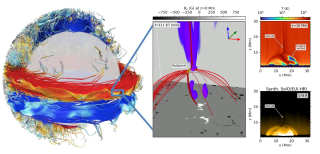Bibcode
Sand, Mats Ola; van der Voort, Luc H. M. Rouppe; Joshi, Jayant; Bose, Souvik; Nóbrega-Siverio, Daniel; Griñón-Marín, Ana Belén
Referencia bibliográfica
Astronomy and Astrophysics
Fecha de publicación:
5
2025
Revista
Número de citas
2
Número de citas referidas
2
Descripción
Context. Spicules are elongated, jet-like structures that populate the solar chromosphere and are rooted in the lower solar atmosphere. In recent years, high-resolution observations and advanced numerical simulations have provided insights into their properties, structures, and dynamics. However, the formation mechanism of spicules, particularly the more dynamic type II spicules, which are primarily found in the quiet Sun and coronal holes, remains elusive. Aims. This study explores whether quiet Sun Ellerman bombs (QSEBs), which are ubiquitous small-scale magnetic reconnection events in the lower atmosphere, are linked to the formation of type II spicules. Methods. We analysed a high-quality 40-minute time sequence acquired with the Swedish 1-m Solar Telescope. Hβ data were used to observe QSEBs and spicules, while spectropolarimetric measurements in the photospheric Fe I 6173 Å line provided line-of-sight magnetic field information. We employed k-means clustering to automatically detect QSEBs and explored their potential association with spicules. Results. We identified 80 clear cases in which spicules occurred soon after the QSEB onset and not later than 30 s after the ending of the QSEBs. In all these instances, the events involved type II spicules, rapidly fading from the images. The footpoints of the spicules seemed to be rooted in QSEBs, where the onset of QSEBs often preceded the formation of the associated spicules. In addition to these clear cases, we found around 500 other events that hinted at a connection but with some ambiguities. The combined clear and ambiguous cases constitute 34% of the total detected QSEBs and a smaller percentage of the spicules in our dataset. Conclusions. Our findings suggest that a fraction of the type II spicules originate from QSEBs, supporting magnetic reconnection as a potential driving mechanism. In this context, QSEBs and spicules represent the conversion of magnetic energy into thermal and kinetic energy, respectively. We suggest that an observational programme including multiple Balmer lines would likely detect more unambiguous connections between QSEBs and spicules.
Proyectos relacionados

El proyecto Whole Sun: desentrañando los complejos mecanismos físicos detrás de nuestra estrella eruptiva y sus gemelos
El Sol es una estrella activa magnéticamente cuyas erupciones violentas pueden impactar y deformar la magnetosfera terrestre y causar perturbaciones importantes en instalaciones tecnológicas en tierra y en órbita. The Whole Sun tiene como objetivo central abordar, de forma coherente y por primera vez, cuestiones actuales clave en Física Solar
Fernando
Moreno Insertis